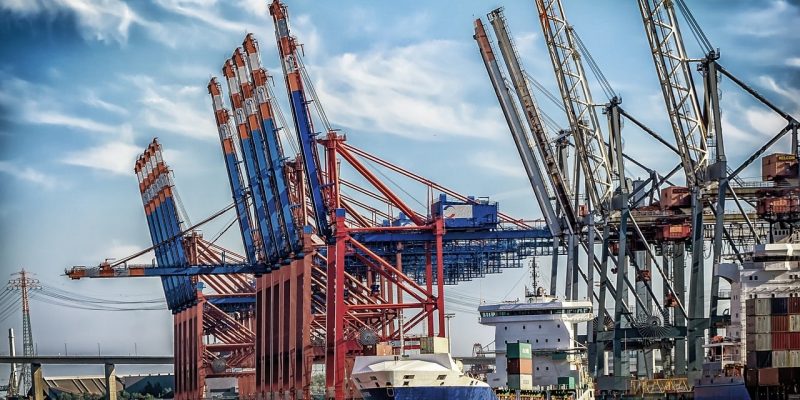There are many steps involved in the shipping process, to get your goods from one country to another. In most cases, this is done by ocean shipping. More than $247 billion worth of items are imported into the United States every month [pdf link], along with more than $200 billion worth of exports. Importing products is a key process when it comes to selling pre-made items. A lot of companies choose to import their products from China, providing for a more cost-effective solution to sell items.
This guide is part of our series on Shipping, for a full overview of shipping check out our ultimate guide on Shipping: Freight Shipping Cost, Steps, and More // Ultimate Guide
Shipping Steps // From The Factory To Its Destination
There are essentially ten important steps that form part of shipping. This particular process applies to shipments from another country. Some steps may seem obvious, but it’s important to clarify with the shipper or freight forwarder who is expected to do which step. The International Chamber of Commerce has codified this process into what is called Incoterms, which you can learn more in our guide on incoterms.
We take a look at each step below to give you a better idea of how shipping from another country works.
Step_01 // Transport To The Export Port
The first step of the shipping process is for the products to be transported to the export port. A pickup needs to be arranged. Some suppliers offer their own transportation services. This helps to get the product to the export port without delay or problems. You might have to arrange with a transportation company if the transport is not offered by the supplier. The products should be packaged and ready for dispatching when it reaches the export port.
Step_02 // Unloading The Carriage In The Export Port
Once the shipment arrives at the export port, it will be unloaded from the transportation carrier. The company in charge of transporting the products from the factory to the export port will likely need to do the unloading here. Products should be unloaded according to regulations provided by the export port. All boxes and containers should have appropriate labels too. This ensures no delay in the shipment of your packages.
Step_03 // Loading Onto The Vessel
After the products have been unloaded from the transportation carriage, it needs to be loaded onto the shipping vessel. Different types of vessels are used for the shipment of these goods. The specific type of vessel will usually depend on the size and weight of your shipment. There will be people at the export port who do the loading of your products onto the vessel.
Step_04 // Export Customs Clearance
Your shipment first needs to be cleared for export before it can be transported to the USA. This process will often be completed automatically, but there are times where certain documentation may be needed. You need to ensure the documentation clearly states the type of products that form part of your shipment. This can help to prevent a delay in your shipment. Shipping will only commence once your package has been provided an export customs clearance.
Step_05 // Shipping On The Vessel
The next step involves the actual shipment of your products. This happens once clearance is provided by the exporting country. The products may be shipped to the destination country via air or sea. Flight transportation is often used when the shipment is not too large and when a faster delivery is needed. Transportation by sea is used for larger and heavier packages. This type of shipment tends to take more time compared to flight, but it may come with a reduced cost – depending on the company providing the shipping service.
Step_06 // Unloading The Vessel At Import Port
When the shipping vessel arrives at the import port, the packages need to be unloaded. This process is handled by the shipping company. Your products will be unloaded from the boat or plane, depending on the type of shipping vessel that was used to transport your packages from the exporting country. At this time, the shipment will be located at the customs office in the destination country.
Step_07 // Import Customs And Clearance
Your package requires an import clearance from the customs office in the destination country before it can be transported to your location. The process can take some time, depending on the number of imports received on a specific date. You should ensure you are available for a phone call and check your emails. You will be contacted to complete some documentation in most cases. The documentation should be completed quickly and sent back to the customs office.
Step_08 // Import Duties And Taxes
Before your package is released from the customs office, there are import duties and taxes that need to be paid. The majority of packages that are imported into the United States will have such fees that need to be paid. You will likely receive an invoice from the customs office. The shipping company handling your shipment may also send you this invoice. The import duties and taxes need to be paid before the package will be released by the customs office.
Step_09 // Loading Of The Carriage In Import Port
Once you have paid the import duties and taxes requested from the customs office, your package will be cleared. At this time, you need to arrange appropriate transport from the customs office to your company’s destination. You will need to ensure the transportation company offers to load the packages. This ensures no delay is experienced to get the products back to your shop.
Step_10 // Unloading At The Destination
The final part of the shipping process is to get the packages unloaded at your destination. Most transportation companies will offer loading and unloading of your shipment. This helps to make things more convenient and speed up the process. If the shipping company does not offer to unload, make sure you have appropriate staff members that can deal with this once the carrier arrives.
Is Freight insurance included?
Freight insurance isn’t always included. In most cases, it’s expected for the Buyer or recipient to purchase. However, you can specify for the shipper to pay for insurance with the CIF incoterm. For more information, please see our guide on Ocean Freight Insurance.
Final Thoughts on The Shipping Process
The shipping process can be rather complex if appropriate steps are not taken. There are essentially ten steps involved when shipping from a third-party country. We looked at these ten steps to help you better understand how it works and what you should expect. Make sure you realize how the shipping process works before you ask for products to be imported.




